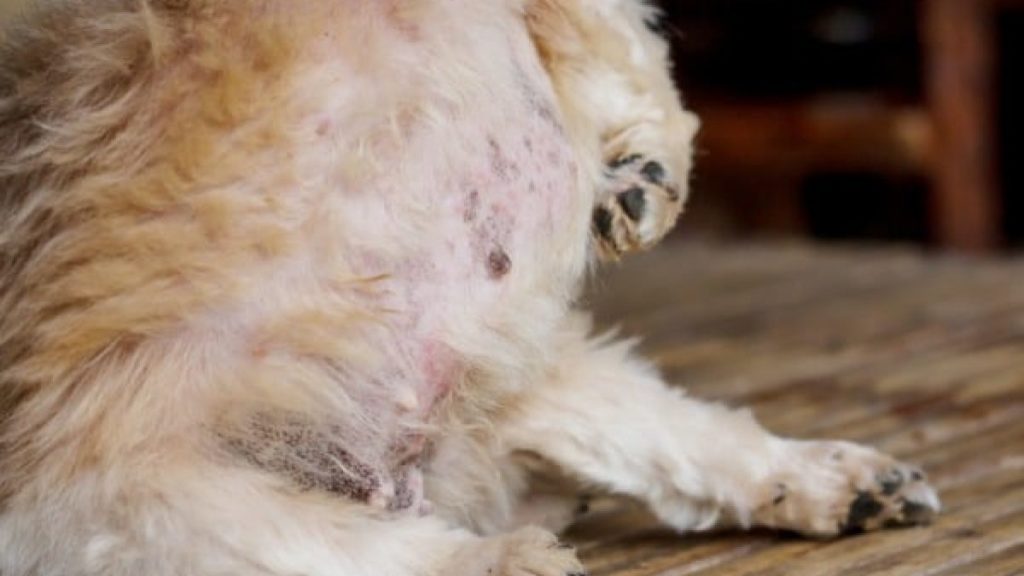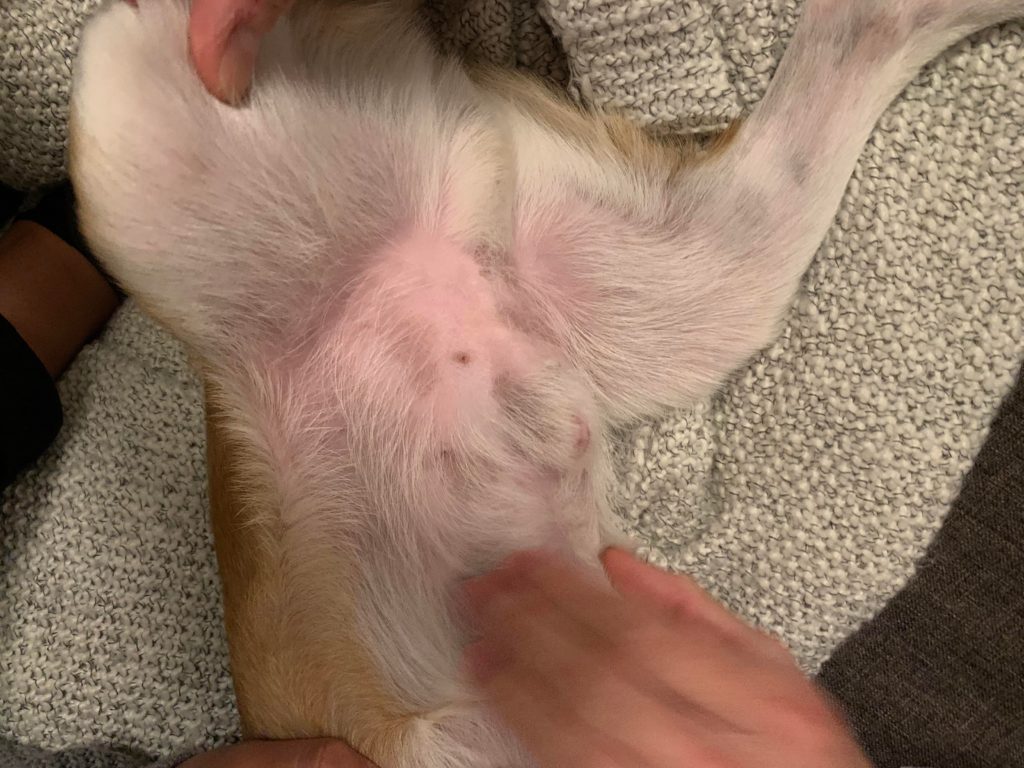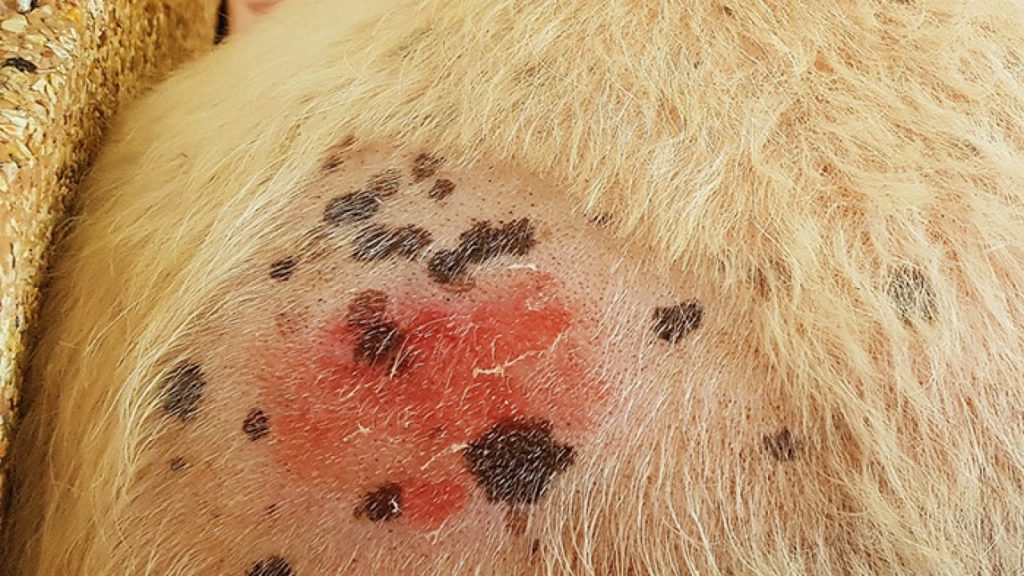Does your dog have dark spots on dog’s belly? Different pigmentations can be found on dogs’ skin. Some areas can be pink or black while others can have different colors. Many dog parents have to ask their pups why their dog’s skin is turning black. Skin hyperpigmentation in dogs (Acanthosis Nigricans), is often secondary to skin conditions or metabolic problems such as allergies, skin infections, or endocrine disorders.
The problem arises when your dog’s skin turns black in areas that were once cute and pink. Many dog owners mistakenly believe that these skin color changes happen quickly. Hyperpigmentation can happen over time. It could have been the bright light in your room that made you notice the change. Or maybe you were just having a weekend cuddle or grooming session and suddenly saw the strange black spots on your dog’s skin.
What is Hyperpigmentation?
Hyperpigmentation may be caused by many things in your dog. Hyperpigmentation can be classified into two types. The primary type will usually show up by the age of one year.
Hyperpigmentation can be caused by other conditions. This may not be an issue in comparison to the larger concerns you have about your dog. You may think your dog has an allergy or skin condition.

Hyperpigmentation occurs when the skin of your dog begins to thicken or darken. Hyperpigmentation does not indicate a specific disease. It is simply a reaction to other skin conditions.
Hyperpigmentation in Dogs: Signs and Symptoms
The signs discussed here are indicative of hyperpigmentation and not the underlying conditions that your dog might be suffering from.
- Coloration – These areas may appear light brown to black.
- Skin changes: The affected area can become rough, velvety, or thickened. There may also be hair loss.
- Hyperpigmentation-prone areas – Your groin, legs, and armpits are all likely to be affected.
- Reddened areas may appear around the edges. This is caused by a yeast or bacterial infection secondary to hyperpigmentation. It can also spread to other parts of his body.
Types
Primary
- Rare – Thoughts to be breed-specific
- This is a common problem in Dachshunds.
- When a child is one year old, signs are usually evident and present.
Secondary
- All dog breeds share this trait.
- Obesity (Labrador Retrievers and Pugs. Dachshunds. English Bulldogs. Cairn Terriers. Beagles. Cocker Spaniels. Rottweilers.
- Hormonal abnormalities
- Allergies (Labrador Retrievers, German Shepherds, Basset Hounds, Jack Russell Terriers, Lhasa Apsos, Irish Setters, Yorkshire Terriers)
- Contact Dermatitis: Border Collies, German Shepherds. Dalmatians. Great Danes. Labradors. Golden Retrievers. Irish Setters.
- Skin infections
Types of Hyperpigmentation in Dogs
Hyperpigmentation does not indicate a particular disease. It is a response of the body to certain conditions. It may appear as light-brown-to-black, rough, and velvety areas of thickened, hairless skin.

Common sites are located in the legs and groin. It can be primary or secondary.
Primary Hyperpigmentation
Although any breed of dog can get skin darkening, Dachshunds are more likely to have it. The signs and symptoms usually become apparent by the time your dog turns one year old.
Treatment of Primary Hyperpigmentation
Primary hyperpigmentation is not curable in Dachshunds. Some pups will only have the condition for cosmetic reasons and don’t need treatment. Shampoo treatment may be helpful in early cases of inflammation.
Other treatments such as injections or oral medication may be necessary as symptoms worsen.
Secondary Hyperpigmentation
Secondary hyperpigmentation can be quite common in all breeds of dogs, particularly those that are prone to obesity, allergies, and hormonal abnormalities. It can also affect skin infections and contact dermatitis.
Secondary hyperpigmentation can be triggered by inflammation and friction. Inflammation is a leading cause of skin problems such as thickened skin, hair loss, pain, and odor.

Reddened edges are a sign that there is secondary yeast infection or bacterial infiltration. The skin discoloration can spread to the lower neck and abdomen, hocks, ears, and eyes, as well as the area between the anus and external organs.
Itching can be unpredictable and is often due to secondary infections or underlying illnesses. Other health problems, such as secondary hair fall, infections, and fluid discharge, can develop as the situation worsens.
Secondary Hyperpigmentation: Treatment
Secondary hyperpigmentation is a condition in which the affected areas of the skin will disappear on their own after the root cause has been identified and treated. If secondary yeast or bacterial infections aren’t treated and controlled, this will not happen.
Most affected dogs will benefit from properly medicated shampoos (2-4 times per week) as well as antibiotics. These treatments may be prescribed by your vet, but it is important to be patient and follow the instructions.
Symptoms of skin darkening are more common and can take several months to resolve.
Hyperpigmentation In Dogs: Diagnosis
Your veterinarian will look for signs and symptoms that indicate hyperpigmentation. Your vet will need to conduct a complete physical exam. To rule out parasites and infections, gentle scrapings may be done on the skin. Food trials can be used to determine if allergies are the problem.
To diagnose hyperpigmentation, no further testing is necessary. To confirm that your veterinarian has found the root cause of your dog’s hyperpigmentation, you may need to have testing done.
Hyperpigmentation in Dogs: Causes
Underlying cause Hyperpigmentation can be:
- Hypothyroidism: Up to 33% of dogs with hypothyroidism had signs of hyperpigmentation.
- Systemic Lupus Erythematosus: Some dogs with lupus
- Hyperpigmentation – Allergies can also occur in dogs who have allergies.
- Hyperpigmentation is a common symptom of yeast infections such as Malassezia.
- Demodicosis is caused by a mite and is a less well-known cause of hyperpigmentation
- Pseudo Cushing’s Syndrome – This is an endocrine condition that can cause hyperpigmentation in dogs of middle age or older.
What Does Some Other Causes Black Spot On Dog Belly?
1. Allergies
Dogs can become allergic to pollen, food, and insects due to their increased exposure to humans. Although the exact cause of allergy may vary, it is possible for dark patches and spots to form on the dog’s skin due to allergic reactions.
- This can lead to patches of thick skin
- Itchy, inflamed skin can also result
- Excessive biting and licking its skin
- Hair loss / Watery eyes / Vomiting/Diarrhea
You will need to consult a veterinarian if you have symptoms of allergy. The vet may prescribe antihistamines and steroids for allergy treatment. These can cause hyperactivity and drowsiness. Be sure to watch your dog closely when you give him medication.
Allergy Remedies for Dogs
Your dog should be fed a diet that supports his immune system to combat allergies. The Allergy Bites are soft-chewy and contain vitamins, proteins, fiber, antioxidants, and other important nutrients.
These soft chews are grain-free and have been proven to be effective for dogs suffering from skin allergies, seasonal allergies, or other allergies. Zesty Paws supplements are among the most effective on the market.
Your dog’s skin will never be the same color as before, but treating chronic skin conditions is important and any underlying causes such as self-trauma and itching.
2. Possibility of Scabies
Canine scabies can be caused by mites. Mites burrow into your dog’s skin, leaving black spots on their ears, elbows, and abdomen. They are also highly contagious so other dogs may spread them to yours.
- Highly contagious
- Sources of contamination – Kennels and Grooming Stations. Parks
You have two options: go to the veterinarian or use the appropriate medical products. You should treat all dogs living in your home, and you should also destroy any bedding. You should also thoroughly clean the environment to eliminate any mites.
Parasitical Remedies For Dogs
Your veterinarian should be consulted if your dog is suffering from an insect infection. This product is not recommended for dogs with fleas or mites.
K9 Advantix II has many products for ticks and fleas. You don’t have to worry if your dog is small. They offer a range of packages that can be used for dogs from small to large.

You can purchase the above-mentioned product if you suspect your dog has internal parasites. You will notice a decrease in appetite and weight as well as declining health conditions like diarrhea, vomiting, and lethargy.
3. Insect Bites
As mentioned above, black spots can be caused by insect bites from ticks and fleas. There is a good chance your dog will be exposed to its environment and get a parasite.
- Fleas – Very common (Causes black spots)
- Common Ticks (Causes of Black Spots)
Fleas and ticks are both parasites that feed off your dog’s blood. Red swellings may occur after they have finished their meal. You should immediately take your dog to the veterinarian if you suspect your dog has fleas or ticks.
4. Yeast Infection
This non-contagious dog’s skin infection is the most common cause of secondary skin infections in dogs. It’s caused by bacteria overgrowth on your dog’s skin. It can start with red rashes, which is a sign of inflammation.
- Hyperpigmentation (Formation Of Black Spots).
- Excessively oily and greasy dog’s skin / Scaly, flaky skin
- Constant Rubbing or Scratching against Objects
- Hair Loss, Drooling, Problems Eating, Losing Weight
Topical treatment with a specialized shampoo can be used to treat yeast dermatitis. Oral treatment is possible if the condition is more severe. Your vet will be able to provide further information and a diagnosis.
Fungal Remedies for Dogs
An antifungal spray can help to cure yeasts infection in dogs. This spray has been reviewed extensively by dog owners. This combination of aloe vera gel and vitamin E can reduce itching and cure yeasts infection.

You can also find an antifungal shampoo that can be used in place of sprays if you prefer. This shampoo was developed by Veterinary Formula Clinical Care and protects against dog skin diseases and parasites.
5. Hemorrhage
Your dog’s blood vessels could become damaged or ruptured from hard contact with rough surfaces. Internal bleeding can cause blood to pool under the skin of your dog, creating dark spots-like marks. In such cases, dark spots can cause severe pain for your dog.
- Black Spots – Trapped blood (causes excruciating pain)
You should immediately take your dog to the vet if you notice black marks on his belly. To avoid your dog losing its life, internal bleeding is a serious condition.
Do You Need Pet Protection?
You might want to consider additional safety measures for your pet before we end. This does not mean that your pet should be isolated from the outside world to reduce the chance of an accident, but that you need a solid plan that you can implement so that your pet is well-informed.
A Petplan is a great option if you’re looking for additional protection for your pet. This pet insurance plan functions in a similar way to your life insurance. Petplan is your financial support in times of need.
This policy may seem unbelievable to you, or perhaps you’ve heard of it before. This policy offers great benefits for your dog’s health and provides medical insurance coverage.
We are grateful that you took the time to read this post. Enjoy the rest of your day and share this post with others if you found it useful.
F.A.Q.
What causes black spots on a dog’s belly?
Dogs with skin problems are often affected by skin conditions such as skin allergies in dogs, scratching, and skin infection due to bacteria. Skin inflammation due to parasites and skin trauma from dogs scratching, biting, and licking their skin is also common. Hyperpigmentation can result from any of these.
Why is my dog getting dark spots on his skin?
Hyperpigmentation can be described as a darkening or thickening of the skin in dogs. … Secondary hyperpigmentation can be quite common in all breeds of dogs, but it is more common in those that are prone to obesity, hormonal abnormalities, and allergies.
What are the spots on my dog’s belly?
It is best to take your dog to a veterinarian if they have dark spots on their stomach that are growing in size or bothersome. You can have these spots caused by allergies, yeast infections, or small cysts, scabs, or tumors.
What are these black spots on my dog?
Hyperpigmentation refers to a darkening or thickening in the skin that can be seen in dogs. Hyperpigmentation is not a disease, but rather a response of the dog’s body towards certain conditions. Hyperpigmentation appears as light-brown-to-black, velvety, rough areas of thickened, often hairless skin. These areas are usually found in the legs or groin.
